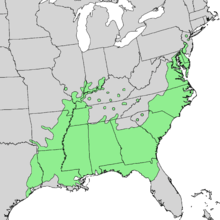Quercus michauxii
| Swamp Chestnut Oak | |
|---|---|
| | |
| A mature Swamp Chestnut Oak | |
| Scientific classification | |
| Kingdom: | Plantae |
| (unranked): | Angiosperms |
| (unranked): | Eudicots |
| (unranked): | Rosids |
| Order: | Fagales |
| Family: | Fagaceae |
| Genus: | Quercus |
| Section: | Quercus |
| Species: | Q. michauxii |
| Binomial name | |
| Quercus michauxii Nutt. | |
 | |
| Natural range of Quercus michauxii | |
Quercus michauxii, the swamp chestnut oak, is a species of oak in the white oak section Quercus section Quercus, native to bottomlands and wetlands in the southern and central United States, from New Jersey south to northern Florida, and west to Missouri and eastern Texas; it is rare north of the Ohio River.
Classification and nomenclature
The swamp chestnut oak closely resembles the chestnut oak Quercus prinus, and for that reason has sometimes been treated as a variety of that species. However, the swamp chestnut oak is a larger tree which differs in preferred habitat, and the bark does not have the distinctive deep, rugged ridging of the chestnut oak, being thinner, scaly, and paler gray. It typically grows to around 65 ft (20 m) tall, though the tallest specimen currently known is over 42m tall.
The name Q. prinus was long used by many botanists and foresters for the swamp chestnut oak, even when treated as a species distinct from the chestnut oak, which was then called Q. montana, but the application of the name Q. prinus to the chestnut oak is now often accepted,[1] although sometimes that name is declared to be of uncertain position, unassignable to either species, with the chestnut oak then called Q. montana, as in the Flora of North America[2]
Description
The leaves of the swamp chestnut oak are simple, 4-11 in (10–28 cm) long and 2-7 in (5–18 cm) broad, with 15-20 lobe-like, rounded simple teeth on each side, similar to those of chestnut oak and chinkapin oak (Quercus muehlenbergii), although they generally do not achieve the more slender form that the leaves of those trees may exhibit at times. The fruit is an acorn 1-1½ in (2.5-3.5 cm) long and ¾-1 in (2-2.5) cm broad, borne on a ¾-1¼ nin (2–3 cm) peduncle, maturing in the fall, about 6 months after pollination.
Uses
The wood of the swamp chestnut oak is similar to, and usually marketed mixed with, other white oaks. The swamp chestnut oak's bark can be sliced into flexible strips suitable for basket weaving, and for this reason the species is sometimes called the "basket oak".[3]
The swamp chestnut oak's acorns are large and relatively sweet.[3] They are readily eaten by livestock,[3] and the species is sometimes called the "cow oak" for this reason. However, swamp chestnut oaks bear heavy crops of acorns only at intervals of several years. Acorns in general are potentially fatal if eaten by equines.
The swamp chestnut oak is sometimes cultivated as a large garden tree or street tree, and is quite easy to grow if it is not subject to extreme urban conditions.
References
- ↑ The confusion arose from differing identifications of the type specimens for the Linnaean name, by some (but not all) botanists considered resolved by close examination of the leaf pubescence, which differs in the two species.
- ↑ "Quercus montana". Flora of North America. Retrieved 8 October 2011.
- ↑ 3.0 3.1 3.2 Kirkman, Brown, Leopold (2007). Native Trees of the Southeast. Portland, Oregon: Timber Press. pp. 182–183.
Other references
| Wikimedia Commons has media related to Quercus michauxii. |